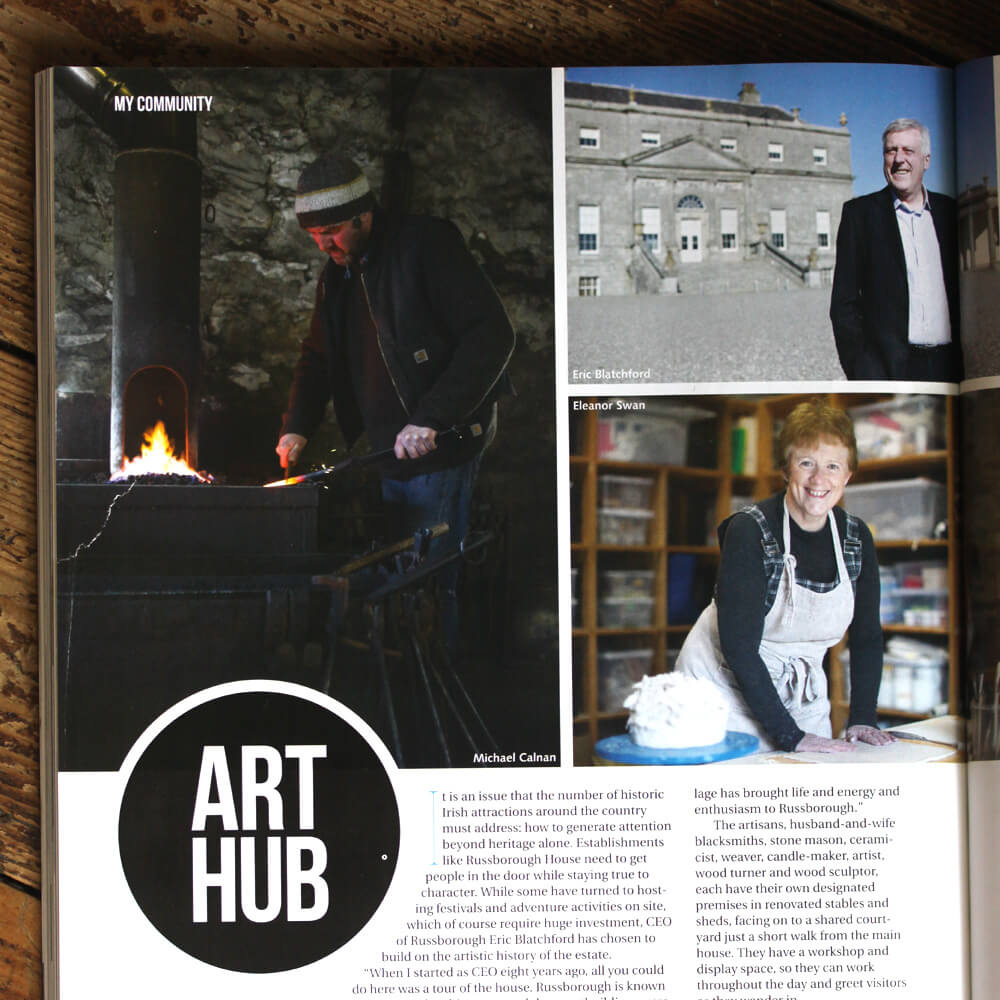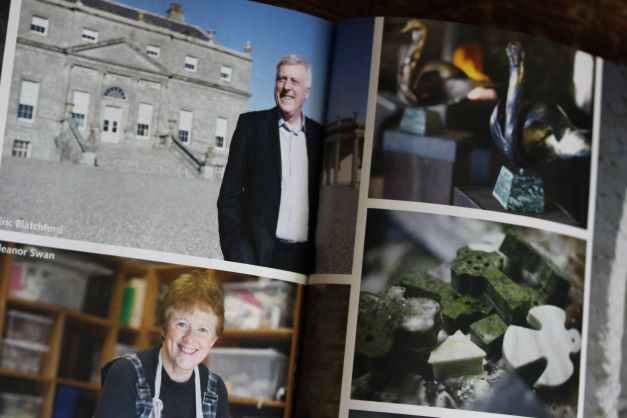Art Hub, Irish Country Magazine 2016

Since the CEO at Russborough House in Co Wicklow invited artisans to take up residence on the grounds, the arrangement has helped breathe life into the estate, and provide these creatives with a supportive community to develop their craft.
It is an issue that the number of historic Irish attractions around the country must address: how to generate attention beyond heritage alone. Establishments like Russborough House need to get people in the door while staying true to the character. While some have turned to hosting festivals and adventure activities on site, which of course require huge investment, CEO of Russborough Eric Blatchford has chosen to build on the artistic history of the estate.
“When I started as CEO eight years ago, all you could do here was a tour of the house. Russborough is known for its art and architecture, and these outbuildings were in a rundown state, absolute ramshackle. Creating a craft village was a way to marry that,” Eric says.
Historically, the outbuildings would have housed the blacksmith’s forge and other craftspeople necessary to the running of the estate, and this gave Eric the idea to offer residencies to artisans. “There were three reasons to do it. First, so the buildings would be occupied and maintained; second, to broaden the strategy of Russborough House; and third, to generate another piece of income, as we are a not-for-profit organisation and the artisans pay us a low rent,” Eric says.
“But of course the real appeal is the community it creates; the artisans will tell you its better for them to be here together than to work on their own. This craft village has brought life and energy and enthusiasm to Russborough.”
The artisans, husband-and-wife blacksmiths, stone mason, ceramicist, weaver, candle-maker, artist, wood turner and wood sculptor, each have their own designated premises in renovated stables and sheds, facing on to a shared courtyard just a short walk from the main house. They have workshop and display space, so they can work throughout the day and greet visitors as they wander in.
Blacksmith Michael Calnan was the first artisan to move in. “I came to meet the CEO and I signed the contracts a week and a half later. Working here, I look out the door and I can see all the seasons. You’re surrounded by nature here and that’s important.”
Meanwhile, Eris Byrne, the stonemason behind Hennessy and Byrne, had been looking for a more suitable location to have a workshop and display space before he came across Russborough two years ago. “I had been working in concrete, steel-roofed industrial unit, and everyone around me was working on cars. But Russborough is a completely different environment; you have beautiful scenery and other creative people around you,” he says. “What is great is I can be continuously working, I don’t have to sit in a showroom waiting for people to arrive that I can sell to. People can see the lovely finished pieces on display in this beautiful showroom which has its own awe factor with the vaulted ceilings, and then through the glass doors they can see the machinery in use in the workshop and what goes into it.”
Eleanor Swan, the ceramicist, specialises in sculptures that help the visually impaired to understand 2D art. Her workspace at Russborough helps give her day structure and also ensures she gets to interact with the outside world. “I was a nurse for 25 years before I went to NCAD and got a degree and a Master’s in design. I then tried working at home for a year, but you don’t get to interact with people. I have been here for five years and it’s a wonderful supportive community. Working in the art world can be airy fairy and scattered but having a designated workspace gives you focus.”
The traffic at Russborough has increased exponentially since the CEO Eric began to diversify the estate.
“It’s no longer just about the house. Now there is the craft village, sheepdog demonstrations, a fairy trail and we’re developing an exciting birds of prey centre. There is something for all generations of the family. Back in the day, maybe 15-20.000 people visited Russborough a year, but the last year we know that we had 100,000.”
The constant flow of potential customers has led to exciting opportunities for the artisans. “You never know who is going to walk through the door,” Eleanor says. “I once had a woman from a German knitting magazine visit and she loved my porcelain tealights. She wrote an article and I did a huge amount of internet sales from that. I never would have met that woman otherwise.”
Eric the stonemason and Michael were also included in the exhibition of 20 artists whose work welcomes visitors to Ireland at Dublin airport. Michael, along with his wife Gunvor Anhoj, also runs workshops from their premises. “It’s also educational to have this craft village. I find that many people expect to find me shoeing horses in here, but then they see these sculptures and their interest is piqued.”
The mutual benefit for tourism destinations like Russborough to link with Ireland’s artistic community is profound, and certainly an idea that could be successfully replicated. “I think every country should have a craft hub, from a tourist point of view. People will be more willing to travel to these destinations around the country, and it can only add to an attraction,” Eric the stonemason says.
And of course for the artisans, not only is the craft village at Russborough House more conductive to creativity and better for business, being part of the artisan community is better for your mental health too. “There is a lot of talk about mental health in the media at the moment, and with the creative industry that is an issue. Artists and artisans are often working from home on their own in sheds and being away from everyone else, and they are completely isolated, but here you have people coming to your door, and you have the support of the other artisans around you.”
